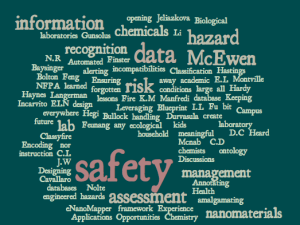Current Topics in Chemical Safety Information
Cosponsored by the Committee on Chemical Safety, Division of Chemical Education and Division of Chemical Information

Organizing chemical information to support lab safety. R. Stuart, L. McEwen
Keeping your kids away from poisonous chemicals N. Qin
Updating NFPA 45: Fire protection for laboratories using chemicals L. Montville
Blueprint for successful chemical management at Yale’s West Campus. C.D. Incarvito, K.M. Heard
Chemistry lab safety information resources for academic user. G. Baysinger
Teaching future chemists how to create meaningful risk assessment tools. S.B. Sigmann
Designing a hazard and risk assessment protocol for undergraduate instruction and use. D.C. Finster
Experience with data handling in large chemical databases. N.R. Langerman
Ensuring that lessons learned are not forgotten: Leveraging ELN to transform the safety paradigm. M. Manfredi, R. Durvasula, W. Bullock, B. Cavallaro, C. Mcnab, M. Nolte, D. Vanderwall
Encoding reactive chemical hazards and incompatibilities in an alerting system. J.W. May, R.A. Sayle
Biological and ecological toxicity of engineered nanomaterials. I.L. Gunsolus, T. Qiu, V. Feng, C.L. Haynes
eNanoMapper: A database and ontology framework for nanomaterials design and safety assessment. B. Hardy, E.L. Willighagen, J. Hastings, M. Hegi, N. Jeliazkova, H. Sarimveis
Data, data everywhere, nor any bit processable: Opportunities for amalgamating and opening up chemical data and information relevant to hazard recognition and safety planning. J. Zhang, P. Thiessen, G. Fu, E. Bolton, L. McEwen
It’s all in how you do it: Annotating process conditions in laboratory chemical hazard recognition and risk management. L. McEwen, Y. Li
Automated Chemical Classification – Classyfire Applications To Chemical Health & Safety– Y. Feunang
CASANDRA: a server for delivering real-time, relevant hazard alerting (view from 5000 ft) J May, D Lowe, and R Sayle, NextMove Software


Does this blog also summarize these meetings? In addition to posting the agenda?
We don’t plan on providing further information about the presentations on this blog, but would be happy to respond to questions such as this one in the comments.
The powerpoint files linked to above are provided to give a sense of the subjects covered by each author. The next step in using this information is for the presenters to develop journal articles based on their presentations; I know that some authors have such articles in the works.